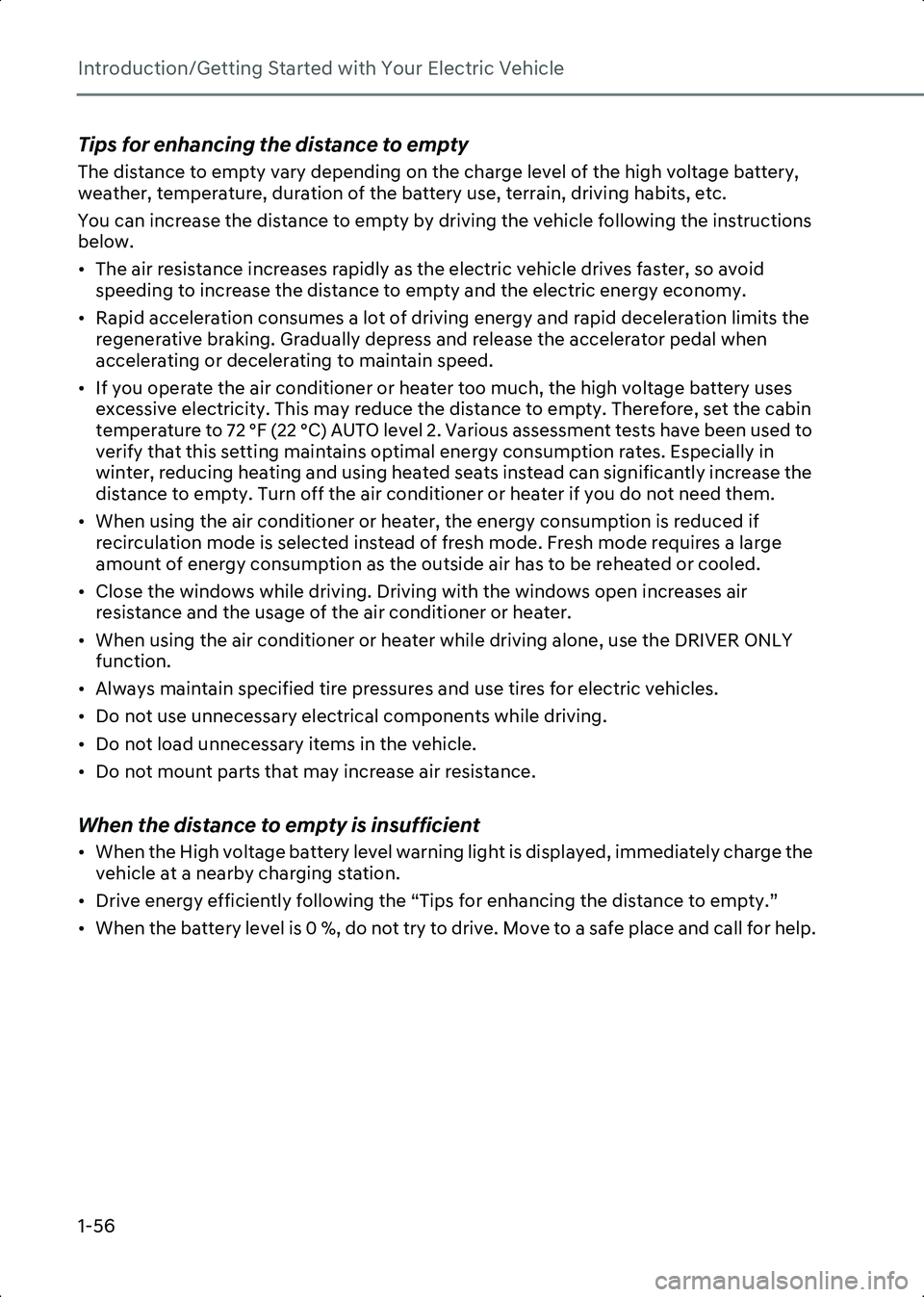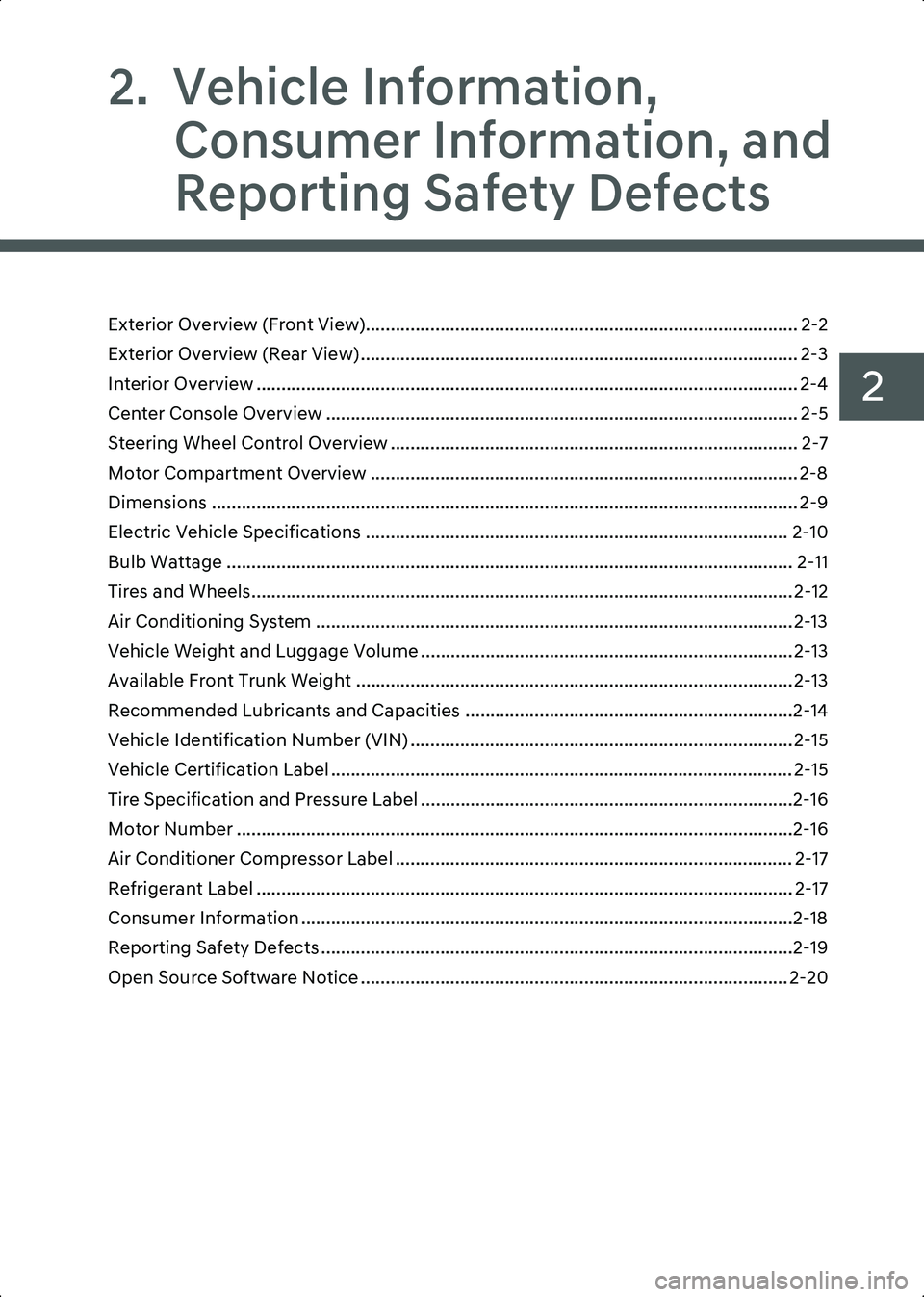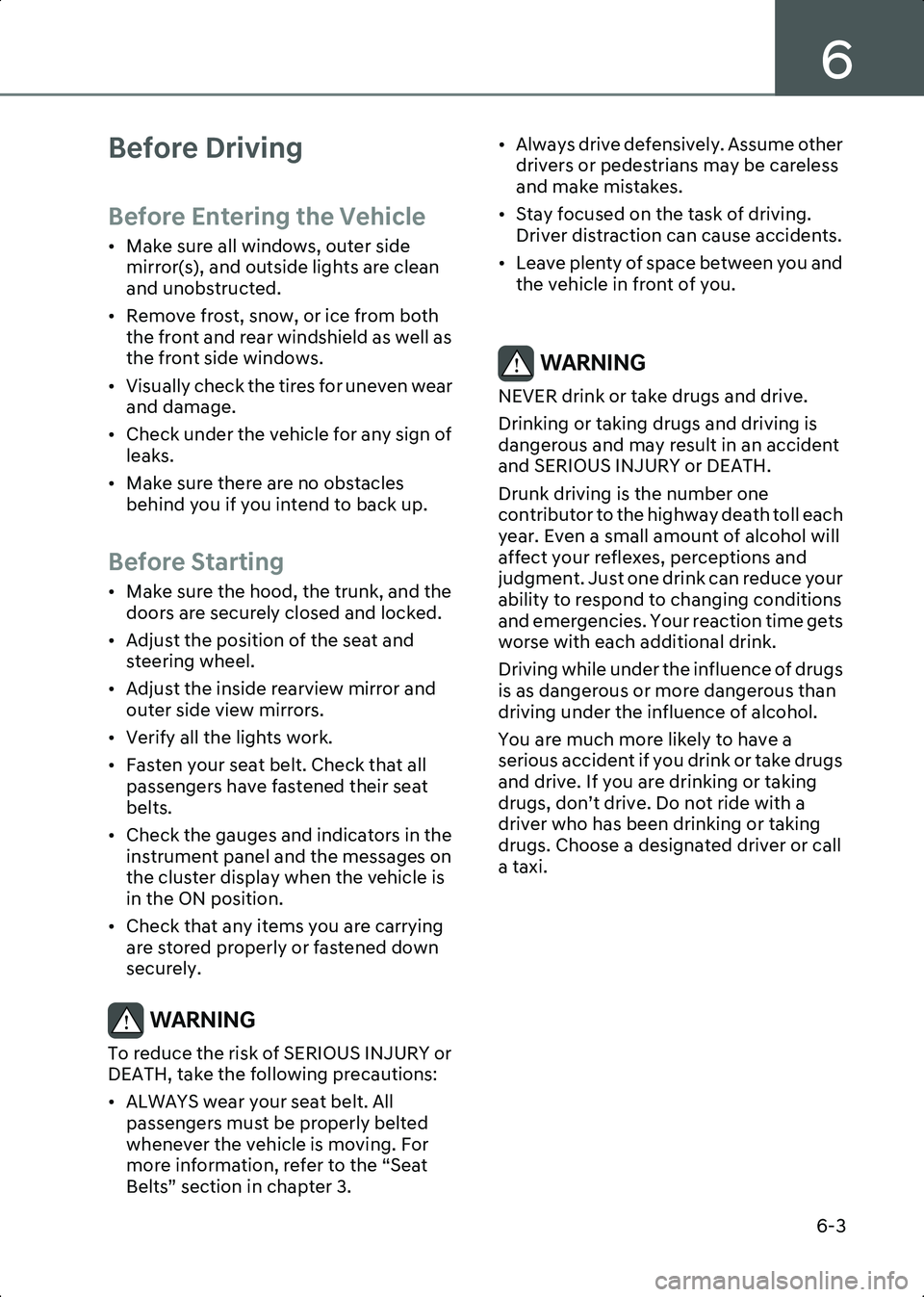2023 HYUNDAI IONIQ 6 tires
[x] Cancel search: tiresPage 16 of 582

Introduction/Getting Started with Your Electric Vehicle
1-10
•Vehicle Control Unit (VCU) : Controls the various controllers and sensors on the
vehicle.
• Motor : Uses electricity accumulated on the high voltage battery to drive the vehicle
(same role as an engine in gasoline vehicles).
• Gear: Delivers the rotational force of the motor to the tires at appropriate speeds and
torque.
• High voltage battery (Lithium-ion battery) : Stores and supplies power necessary for
the electric vehicle to operate. (The separately installed 12 V battery provides power to
the vehicle when the vehicle is in ACC or OFF.)
WARNING • Do not remove or disassemble any high voltage battery’s connectors and wires. Doing so may lead to accidents, such as electric shock, and result in serious injury and
significantly degrade the vehicle’s performance and durability.
• When the high voltage battery or its related components require inspection and maintenance, contact an authorized HYUNDAI dealer.
Precautions When Using the High Voltage Battery
Precautions for high voltage battery when driving and storing the vehicle are as follows:
CAUTION • Keep the gauge of the high voltage battery from going below 10 %. Storing the vehicle while the battery level is too low for a long time may damage the battery or reduce the
battery’s capacity.
• If a collision occurs and the vehicle is impacted, have the vehicle inspected by an authorized HYUNDAI dealer and check the battery connection status.
• Using the V2L function may reduce the driving distance due to the use of high voltage battery energy, and repeated use of the V2L function may impact battery life.
• Frequent use of DC charging may impact battery life.
• The high voltage battery level may reduce naturally even if the vehicle is not driven.
• Storing the vehicle in temperatures that are too hot or cold may degrade the battery performance.
• The distance to empty or power output may vary depending on the driving conditions, such as the outside temperature. Driving on highway at high speeds or uphill will
increase battery consumption, resulting in a shorter distance to empty.
• If you use the air conditioner or heater, which is powered by the high voltage battery, the distance to empty will be reduced. Maintain reasonable temperature when using
the air conditioner or heater to maximize distance to empty.
• Depending on the vehicle’s period of use, natural degradation of the battery may occur that reduces distance to empty over long period of vehicle life. When the charge
Hyundai_CE_en_US.book Page 10
Page 62 of 582

Introduction/Getting Started with Your Electric Vehicle
1-56
Tips for enhancing the distance to empty
The distance to empty vary depending on the charge level of the high voltage battery,
weather, temperature, duration of the battery use, terrain, driving habits, etc.
You can increase the distance to empty by driving the vehicle following the instructions
below.
• The air resistance increases rapidly as the electric vehicle drives faster, so avoid speeding to increase the distance to empty and the electric energy economy.
• Rapid acceleration consumes a lot of driving energy and rapid deceleration limits the regenerative braking. Gradually depress and release the accelerator pedal when
accelerating or decelerating to maintain speed.
• If you operate the air conditioner or heater too much, the high voltage battery uses excessive electricity. This may reduce the distance to empty. Therefore, set the cabin
temperature to 72 °F (22 °C) AUTO level 2. Various assessment tests have been used to
verify that this setting maintains optimal energy consumption rates. Especially in
winter, reducing heating and using heated seats instead can significantly increase the
distance to empty. Turn off the air conditioner or heater if you do not need them.
• When using the air conditioner or heater, the energy consumption is reduced if recirculation mode is selected instead of fresh mode. Fresh mode requires a large
amount of energy consumption as the outside air has to be reheated or cooled.
• Close the windows while driving. Driving with the windows open increases air resistance and the usage of the air conditioner or heater.
• When using the air conditioner or heater while driving alone, use the DRIVER ONLY function.
• Always maintain specified tire pressures and use tires for electric vehicles.
• Do not use unnecessary electrical components while driving.
• Do not load unnecessary items in the vehicle.
• Do not mount parts that may increase air resistance.
When the distance to empty is insufficient
• When the High voltage battery level warning light is displayed, immediately charge the vehicle at a nearby charging station.
• Drive energy efficiently following the “Tips for enhancing the distance to empty.”
• When the battery level is 0 %, do not try to drive. Move to a safe place and call for help.
Hyundai_CE_en_US.book Page 56
Page 75 of 582

2
2. Vehicle Information, Consumer Information, and
Reporting Safety Defects
Exterior Overview (Front View)....................................................................................... 2-2
Exterior Overview (Rear View) ........................................................................................ 2-3
Interior Overview ............................................................................................................. 2-4
Center Console Overview ............................................................................................... 2-5
Steering Wheel Control Overview .................................................................................. 2-7
Motor Compartment Overview ...................................................................................... 2-8
Dimensions ...................................................................................................................... 2-9
Electric Vehicle Specifications ..................................................................................... 2-10
Bulb Wattage .................................................................................................................. 2-11
Tires and Wheels............................................................................................................. 2-12
Air Conditioning System ................................................................................................2-13
Vehicle Weight and Luggage Volume ...........................................................................2-13
Available Front Trunk Weight ........................................................................................2-13
Recommended Lubricants and Capacities ..................................................................2-14
Vehicle Identification Number (VIN) ............................................................................. 2-15
Vehicle Certification Label ............................................................................................. 2-15
Tire Specification and Pressure Label ...........................................................................2-16
Motor Number ................................................................................................................2-16
Air Conditioner Compressor Label ................................................................................ 2-17
Refrigerant Label ............................................................................................................ 2-17
Consumer Information ...................................................................................................2-18
Reporting Safety Defects ...............................................................................................2-19
Open Source Software Notice ...................................................................................... 2-20
Hyundai_CE_en_US.book Page 1
Page 76 of 582

Vehicle Information, Consumer Information, and Reporting Safety Defects
2-2
Exterior Overview (Front View)
A1000201The actual shape may differ from the illustration.
(1) Hood .......................................................................................................................... 5-53
(2) Headlight ..................................................................................................................9-44
(3) Tires and wheels .......................................................................................................9-20
(4) Side view mirror ....................................................................................................... 5-43
(5) Wide sunroof ............................................................................................................5-50
(6) Front windshield wiper blades ................................................................................ 9-15
(7) Window ..................................................................................................................... 5-46
(8) Wide-front view camera .......................................................................................... 7-98
(9) Front radar .................................................................................................................. 7-7
1
2
3
3
5
6
7
8
9
4
Hyundai_CE_en_US.book Page 2
Page 86 of 582

Vehicle Information, Consumer Information, and Reporting Safety Defects
2-12
Tires and Wheels
NOTICE • It is permissible to add 3 psi (20 kPa) to the standard tire pressure specification if colder temperatures are expected soon. Tires typically lose 1 psi (7 kPa) for every 12 °F (7 °C)
temperature drop. If extreme temperature variations are expected, recheck your tire
pressure as necessary to keep them properly inflated.
• Tire inflation pressures may vary depending on changes in elevation. If driving in areas of higher or lower elevation, be sure to check and adjust for proper tire inflation.
• Do not exceed the maximum inflation pressure, as found on the sidewall of the tire(s).
CAUTION When replacing tires, ALWAYS use the same size, type, brand, construction and tread
pattern supplied with the vehicle. If not, it can damage the related parts or make it work
irregularly.
ItemsTire SizeWheel SizeBattery Type
Inflation Pressure psi (kPa)Wheel Lug
Nut Torque
lbf-ft (kgf-m, N-m)
Normal LoadMaximum Load
FrontRearFrontRear
Full Size Tire 225/55R18 7.5J X 18
2WD
Standard 38
(260) 38
(260) 38
(260) 38
(260)
79-94 (11-13, 108-127)
225/55R18 7.5J X 18
2WD
Extended 38
(260) 38
(260) 38
(260) 38
(260)
225/55R18 7.5J X 18 AWD
Extended 36
(250) 36
(250) 36
(250) 36
(250)
245/40R20 8.5J X 20 2WD
Extended 36
(250) 37
(255) 36
(250) 37
(255)
245/40R20 8.5J X 20 AWD
Extended 36
(250) 37
(255) 36
(250) 37
(255)
Hyundai_CE_en_US.book Page 12
Page 90 of 582

Vehicle Information, Consumer Information, and Reporting Safety Defects
2-16
Tire Specification and
Pressure Label
ONE1011025L
The tires supplied on your new vehicle are
chosen to provide the best performance
for normal driving.
The tire label located on the driver’s side
center pillar gives the tire pressures
recommended for your vehicle.
Motor Number
2WD/AWD
B1002401AWD
B1002402
The motor numbers can be checked at
the bottom of the vehicle.
Hyundai_CE_en_US.book Page 16
Page 161 of 582

4
4-11
Low Tire Pressure Warning Light
WL_TPMSWarningLamp
This warning light illuminates:
• When the Start/Stop button is in the ON position. The low tire pressure warning
light illuminates for about 3 seconds
and then goes off.
• When one or more tires are significantly underinflated. (The location of the
underinflated tire appears on the
instrument cluster.)
For more information, refer to the “Tire
Pressure Monitoring System (TPMS)”
section in chapter 8.
This warning light remains ON after
blinking for about 60 seconds, or
repeatedly blinks ON and OFF in 3 second
intervals:
When there is a malfunction with the
TPMS.
If this occurs, have the vehicle inspected
by an authorized HYUNDAI dealer as soon
as possible.
For more information, refer to the “Tire
Pressure Monitoring System (TPMS)”
section in chapter 8.
WARNING • The TPMS cannot alert you to severe and sudden tire damage caused by
external factors.
• If you notice any vehicle instability, immediately take your foot off the
accelerator pedal, apply the brakes
gradually with light force, and slowly
move to a safe position off the road.
Driver Attention Warning Light
WL_DriverAttentionWarningLamp
This warning light illuminates:
• When you set the ignition switch to the ON position, the yellow indicator light
illuminates for about 3 seconds and
then goes off
• [Continuously Yellow] When the front view camera is blocked or Driver
Attention Warning is
disable/malfunction
• [Blinking Yellow] When the function suggest that the driver take a break
If the yellow warning light is still on even
after removing foreign material from the
front of the sensor, have the vehicle
inspected by an authorized HYUNDAI
dealer as soon as possible
For more information, refer to the “Driver
Attention Warning (DAW)” section in
chapter 7
Forward Safety Warning Light
WL_FrontSafetyWarningLamp
This warning light illuminates:
• When the Start/Stop button is in the ON position. The Forward Safety warning
light illuminates for about 3 seconds
and then goes off.
• [Yellow] When Forward Safety is deselected or Forward
Hyundai_CE_en_US.book Page 11
Page 291 of 582

6
6-3
Before Driving
Before Entering the Vehicle
• Make sure all windows, outer side mirror(s), and outside lights are clean
and unobstructed.
• Remove frost, snow, or ice from both the front and rear windshield as well as
the front side windows.
• Visually check the tires for uneven wear and damage.
• Check under the vehicle for any sign of leaks.
• Make sure there are no obstacles behind you if you intend to back up.
Before Starting
• Make sure the hood, the trunk, and the doors are securely closed and locked.
• Adjust the position of the seat and steering wheel.
• Adjust the inside rearview mirror and outer side view mirrors.
• Verify all the lights work.
• Fasten your seat belt. Check that all passengers have fastened their seat
belts.
• Check the gauges and indicators in the instrument panel and the messages on
the cluster display when the vehicle is
in the ON position.
• Check that any items you are carrying are stored properly or fastened down
securely.
WARNING To reduce the risk of SERIOUS INJURY or
DEATH, take the following precautions:
• ALWAYS wear your seat belt. All passengers must be properly belted
whenever the vehicle is moving. For
more information, refer to the “Seat
Belts” section in chapter 3. • Always drive defensively. Assume other
drivers or pedestrians may be careless
and make mistakes.
• Stay focused on the task of driving. Driver distraction can cause accidents.
• Leave plenty of space between you and the vehicle in front of you.
WARNING NEVER drink or take drugs and drive.
Drinking or taking drugs and driving is
dangerous and may result in an accident
and SERIOUS INJURY or DEATH.
Drunk driving is the number one
contributor to the highway death toll each
year. Even a small amount of alcohol will
affect your reflexes, perceptions and
judgment. Just one drink can reduce your
ability to respond to changing conditions
and emergencies. Your reaction time gets
worse with each additional drink.
Driving while under the influence of drugs
is as dangerous or more dangerous than
driving under the influence of alcohol.
You are much more likely to have a
serious accident if you drink or take drugs
and drive. If you are drinking or taking
drugs, don’t drive. Do not ride with a
driver who has been drinking or taking
drugs. Choose a designated driver or call
a taxi.
Hyundai_CE_en_US.book Page 3